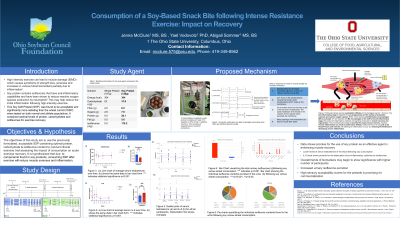Back

Objectives: To assess the effectiveness of a novel soy pretzel (NSP) in mitigating symptoms of exercise induced muscle damage (EIMD). Due to the high levels of protein and isoflavones found in soy, it is hypothesized that consumption of NSP after exercise will reduce muscle soreness and inflammation.
Methods: Ten male subjects between the ages 18-30 completed a double-blind crossover study and were randomly assigned to consume either the study agent or placebo. The exercise protocol involved repeated bouts of eccentric exercise in the form of a squat. 6 sets of 10 repetition squats at 70% 1 repetition maximum was selected to induce muscle damage. Blood was collected pre- and post-exercise in an effort to capture the peaks of various biomarkers. Urine was collected for 24 hours starting immediately after exercise to assess urinary isoflavone content. Muscle soreness was assessed using a visual analog scale. Sensory acceptability scores were collected using a 9-point hedonic scale.
Results: Both pretzels had high acceptability scores of 7 out of 9. Testosterone was significantly blunted in the serum following soy (418.96 ± 146.21) compared to wheat (471.31 ± 166.07), indicating increased uptake by the muscle due to protein and essential amino acids found in NSP (p=0.0072). Creatine Kinase and myoglobin peaked higher in soy than wheat, however, attenuated faster in the treatment arm. The same pattern was observed for proinflammatory cytokines IL-6 and TNF-a. IL-6, while significantly higher in soy, attenuated faster starting at the 6-hour time point. Isoflavones peak in the blood 6 hours after consumption, suggesting they may be responsible for the rapid decline following soy consumption. Urinary isoflavones daidzein, genestein, glycitein were all significantly elevated (p < 0.001, 0.011 and 0.011 respectively) following soy consumption as were ODMA and formononetin, indicating that a one-time dose of soy, is sufficient to elevate urinary excretion.
Conclusions: Significantly lower levels of serum testosterone and more rapid decreases in biomarkers of inflammation and muscle damage provide support for the use of NSP in an acute setting to mitigate symptoms of EIMD. Additionally, the soy pretzel received high sensory acceptability scores among the target population, which is promising for future commercialization.
Funding Sources: The Ohio Soybean Council
Food Science and Nutrition
(PO14-21-22) Consumption of a Soy Snack Bite After Resistance Exercise: Impact on Recovery in Athletes


Jenna McClure, MS, BS
– Graduate Research Associate, The Ohio State University, COLUMBUS, Ohio, United States
Presenting Author(s)
Disclosure(s):
Jenna McClure, MS, BS: No relevant financial relationship(s) with ineligible companies to disclose.
Objectives: To assess the effectiveness of a novel soy pretzel (NSP) in mitigating symptoms of exercise induced muscle damage (EIMD). Due to the high levels of protein and isoflavones found in soy, it is hypothesized that consumption of NSP after exercise will reduce muscle soreness and inflammation.
Methods: Ten male subjects between the ages 18-30 completed a double-blind crossover study and were randomly assigned to consume either the study agent or placebo. The exercise protocol involved repeated bouts of eccentric exercise in the form of a squat. 6 sets of 10 repetition squats at 70% 1 repetition maximum was selected to induce muscle damage. Blood was collected pre- and post-exercise in an effort to capture the peaks of various biomarkers. Urine was collected for 24 hours starting immediately after exercise to assess urinary isoflavone content. Muscle soreness was assessed using a visual analog scale. Sensory acceptability scores were collected using a 9-point hedonic scale.
Results: Both pretzels had high acceptability scores of 7 out of 9. Testosterone was significantly blunted in the serum following soy (418.96 ± 146.21) compared to wheat (471.31 ± 166.07), indicating increased uptake by the muscle due to protein and essential amino acids found in NSP (p=0.0072). Creatine Kinase and myoglobin peaked higher in soy than wheat, however, attenuated faster in the treatment arm. The same pattern was observed for proinflammatory cytokines IL-6 and TNF-a. IL-6, while significantly higher in soy, attenuated faster starting at the 6-hour time point. Isoflavones peak in the blood 6 hours after consumption, suggesting they may be responsible for the rapid decline following soy consumption. Urinary isoflavones daidzein, genestein, glycitein were all significantly elevated (p < 0.001, 0.011 and 0.011 respectively) following soy consumption as were ODMA and formononetin, indicating that a one-time dose of soy, is sufficient to elevate urinary excretion.
Conclusions: Significantly lower levels of serum testosterone and more rapid decreases in biomarkers of inflammation and muscle damage provide support for the use of NSP in an acute setting to mitigate symptoms of EIMD. Additionally, the soy pretzel received high sensory acceptability scores among the target population, which is promising for future commercialization.
Funding Sources: The Ohio Soybean Council

.png)
